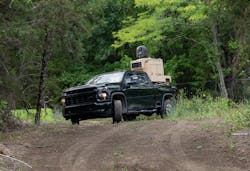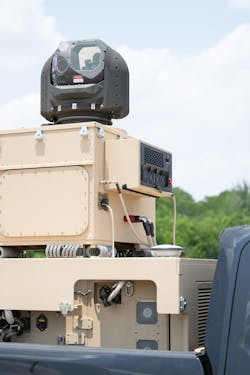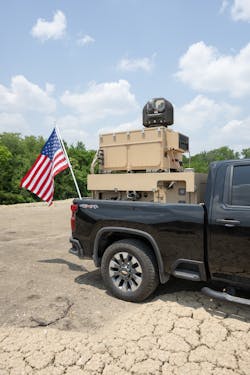‘On-the-go’ high-energy laser weapon system counters drone threats
Nearly every recent headline out of Ukraine and other war zones mentions drone attacks, because they’ve become such a cheap and ubiquitous way to inflict damage or to spy and collect data. Even the cheapest drones can now be easily modified with little sophistication and used in an attack. And since they’re so cheap, swarms also pose a threat.
Raytheon’s H4, its latest 10 kilowatt (10 kW) high-energy laser (HEL) weapon system, is designed for the U.S. Air Force to be easily portable and protect against short-range aerial threats (see Fig. 1 and video). It can target, track, and destroy Class 1 or Class 2—small- to medium-sized—drones in not only short- and long-range attacks, but also swarm attacks.
While HELs are an extremely effective approach to counter drone threats, they aren’t a magic bullet and missiles will always be required to take down larger drones.
“You aren’t going to shoot a laser in a rain storm, but you also aren’t going to shoot a $1 million missile at a drone because you’d quickly lose the battle of economics,” says Michael Hofle, senior director of HEL weapon systems for Raytheon Technologies, an RTX business. “There are going to be a lot of technologies to address drone threats, but lasers will be a key piece to combat it.”
Ruggedized and portable HELs
Battlefields are notoriously chaotic, and Raytheon’s H4 is built from lessons learned in real combat environments to address this: it’s now completely sealed and fully ruggedized.
To make the system easily portable, it’s sized to fit into the back of a pickup (see Fig. 2). “The Air Force requested this palletized configuration,” Hofle says.
The H4 is designed for counter-drone missions, as well as intelligence, surveillance, and reconnaissance (ISR) missions, and HELs at this power level (10 kW) tend to be targeted at countering Class 1 or Class 2 drones.
“Its counter-drone piece gets most of the attention, because we’re able to focus an intense amount of energy on a dime-sized spot on a drone to basically melt it out of the sky,” says Hofle. “But the other advantage of these systems is a world-class electro-optic/infrared (EO/IR) optical system you can run 24-7 for ISR to scan night and day for situational awareness. It’s really a double punch of combining this incredible optical system and the defensive effector with the laser.”
Interestingly, the H4 is powered by technology from F-1 race car batteries because they can store a lot of power and charge constantly without melting down. “We put some unique battery chemistry into it, so it’s got all of the energy storage and the ability to recharge while operating,” Hofle says. “If you plug it into a wall, it can run indefinitely. Or you can have a standard generator next to it on the battlefield to charge it off of diesel fuel.”
While fully sealed now, the system does still require some light maintenance. “Air filters need to be cleaned every few months and if you have bug splatter on the main aperture, you’ll to need to clean it off,” says Hofle.
Ready to be greenlighted?
One big open question, for many years, within the military laser community is: when are HELs going to be on the battlefield in decent numbers?
From a technology perspective, HELs are mature. “The laser side is definitely mature, and the magic behind amplifiers is solved—we know how to build powerful amplifiers and combine them,” says Hofle. “The real secret sauce now is in the beam director technology. Lasers will commoditize, so the technology behind building high-quality beam directors is the new discriminator.”
Raytheon’s strategy is to minimize the cost and increase the production capability of HELs, so their beam directors are built at their facility in McKinney, TX, where they build all of their EO/IR sensors of the same architecture.
“Any time we upgrade our EO/IR sensors, we adapt the technology for our laser systems,” says Hofle. “Typically, beam directors are bespoke items, one-offs, not something built in mass quantities or even small quantities. We’ve built two of our designs in close to double digits, which is pretty unheard of for a laser system.”
As far as possible improvements, the H4 is in line with what Raytheon’s deploying on EO/IR sensors, and this commonality helps reduce costs and improve the manufacturability of their beam director.
“We’re not one-off designing these handcrafted beam directors anymore, which is pretty much what’s been going on within the industry if you look across all of the various laser programs going back to the 1990s,” Hofle explains. “You’d build one, and then the program would end up getting mothballed.”
Raytheon has invested heavily in its manufacturing capability “and we’re ready to go,” says Hofle. “We have the inventory and can pull beam directors off the factory floor from the EO/IR sensors side. Whenever the demand signal hits, and we’re all waiting for this signal, we’re well positioned to meet the demand.”
A future of HELs countering hypersonics?
Hypersonic missiles are garnering lot of attention, primarily because of their speed (faster than Mach 5) and maneuverability to avoid radar detection, and the question of whether or not a HEL can be used to counter them tends to pop up.
“The rationale is that one of the advantages of laser weapon systems is its ‘bullets’ travel at the speed of light because you’re shooting photons,” says Hofle. “The nanosecond you see something out there, you can put an effector (which performs a type of action in response to something a sensor detects) on it. As a hypersonic problem, since it’s moving really fast, you naturally think of lasers because you can have an effector at the speed of light. What better way to try to shoot something down than that?”
But, unfortunately, while deploying a 10 kW high-energy laser weapon system is happening today, shooting down a hypersonic with one of these laser systems is still very much in the future. “You’re not shooting down a hypersonic with a 10 kW laser,” Hofle points out. “You’d need more like hundreds of kilowatts and it’s a much harder problem and no one’s done it yet. Could we see it someday? Yes—but it’s a really tough problem.”
About the Author
Sally Cole Johnson
Editor in Chief
Sally Cole Johnson, Laser Focus World’s editor in chief, is a science and technology journalist who specializes in physics and semiconductors.



